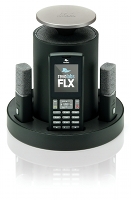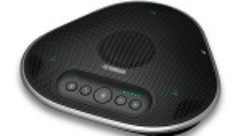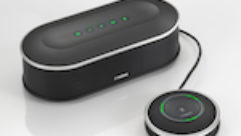

Revolabs FLX2 Conference Phone
Oct 12, 2011 11:29 AM,
by John McJunkin
A compact but advanced modular teleconferencing system.
Revolabs FLX2 Conference Phone
Revolabs is the manufacturer of wireless audio solutions for a broad range of applications from business to HOW to broadcast. In particular, the company offers an array of phone conferencing products ranging from simple to moderately sophisticated. In June, Revolabs introduced its FLX conference phone, intended for small to mid-sized conference rooms. According to Revolabs, it has leveraged advanced technology previously used in only its larger, more sophisticated offerings to bring a higher level of quality to teleconferencing in smaller offices and environments. The very latest version of the system is the FLX2, and I received one for evaluation and spent some time with it.
I was aware that the FLX2 was modular in nature, with several components comprising the system, so I expected a little complexity at the time of unboxing and setup. I was pleasantly surprised to discover just six total parts, a speaker, two microphones, a dialer unit, a charger, and a base station. From the standpoint of operational aesthetics, this system is fantastic. The cylindrical speaker sits in a recessed circular space in the charger unit. Surrounding that space are rounded rectangular recessed spaces for the system’s two microphones and dialer unit. The mics, dialer, and speaker communicate wirelessly with the rectangular base station to get signals in and out of the room. I removed all the components from the compact shipping box and was surprised at the small physical size of the system, and it became abundantly clear what went where—no guesswork or pulling out the manual for this part of the process.
Indeed, when reviewing products, I normally attempt to get as far into the setup and configuration process as possible without cracking the manual, and I always hope to get so far as to fully use the product as intended without ever needing to consult the documentation. In the case of the FLX2, I knew that I’d need to dig in on some of the more sophisticated aspects such as Bluetooth operation, but as far as the fundamental setup and use, it was very smooth sailing. I plugged the base station into the phone line, placed the speaker unit in the middle of the table, placed the table remote mic in front of one attendee, clipped the other to another attendee, turned the mics on, and dialed up the call. The party on the other end of the phone was pleasantly surprised and very satisfied with the clarity of our voices over the telephone. The surprise arose from the fact that each voice from our end sounded to the other party as though they were each on their own handset or headset. As to the quality of the signal coming from the other end, I was frankly shocked with the richness, fullness, and substantial volume of the voice. This system clearly leverages the entirety of the bandwidth available in modern POTS (plain old telephone service) systems. The system’s AEC (acoustic echo cancellation) also contributes to the excellent fidelity.
The FLX2 has the capacity to place a call through a mobile phone or computer via Bluetooth, which I proceeded to test next. I was easily able to pair my 2006 MacBook with the system, but could not pass audio either direction, likely because the Bluetooth implementation on my Mac does not meet the minimum HFP (hands-free profile) necessary for operation with the FLX2. Unfortunately, I was not able to pair the system with my Motorola MotoRAZR V3m, which is ancient in terms of mobile phones, and only offers Bluetooth 1.0 (the FLX2 requires Bluetooth 2.0). I’m very certain that the system would effortlessly pair with a more modern phone.
The beauty of having this capacity should be pretty self-evident. The FLX2 is so small and compact, it could easily be packed in one’s luggage for a business trip and used with one’s mobile phone to make conference calls with team members gathered around the table. And despite the issues I experienced with my MacBook, I’m quite certain that the FLX could be used to connect via Skype with more up-to-date computers, opening up tremendous possibilities. Theoretically, since the audio bandwidth (and overall quality) of Skype is vastly greater than POTS, the conferencing experience should even be superior to what I experienced with POTS. Presumably, the Bluetooth functionality would also facilitate the use of a Bluetooth earpiece by a conference attendee (although the system can only handle up to four Bluetooth devices total). The inclusion of Bluetooth capability in light of the system’s price is a very pleasant surprise.
The system’s dialer unit not only facilitates the initiation of a call, but it is also the controller for the entire system, granting the ability to dig into the system’s menus and various parameters. It’s also a full-featured telephone handset, enabling taking or making a call in the traditional way. It stores contacts, which is nice if conference calls are made to the same numbers frequently. It also features a mute button to turn off its microphone during a call. It offers hold and call-waiting capabilities, and it can establish a conference call with a second phone number. In the unlikely event that you find the fidelity lacking, the dialer unit also offers control over levels and basic equalization (treble and/or bass boost).
Revolabs FLX2 Conference Phone
Oct 12, 2011 11:29 AM,
by John McJunkin
A compact but advanced modular teleconferencing system.
The base station offers mini-jack audio connections to facilitate videoconferencing via computer or third-party video system, and the entire system employs RF shielding (known by Revolabs as “RF Armor”) to reject interference from all RF devices, mobile phones in particular. During the evaluation time I spent with the system, I never heard any kind of RF interference whatsoever. And as I said, the sound fidelity was very good.
The two mics are each intended for slightly different purposes. One is a clip-on mic that is intended to follow along with a meeting leader, particularly if that person is going to move around, perhaps in the process of delivering a PowerPoint presentation. The other mic is intended as a tabletop device, and I put it through its paces by moving it substantial distances from a single attendee and discovered that it still conveyed that person’s voice very clearly to the person on the other end.
The Revolabs FLX2 conference phone is a moderately sophisticated modular system that provides truly excellent call fidelity going both ways, and offers some very nice additional capacities, the most impressive of which, in my mind, is Bluetooth functionality. Considering the price tag, I’d strongly recommend taking a look at this system if you need a good solution on a limited budget.
John McJunkin is the principal of Avalon Podcasting in Chandler, Az. He has consulted in the development of studios and installations and provides high-quality podcast production services.
Product Summary:
- Company: Revolabs
www.revolabs.com - Product: FLX2
- Pros: Excellent sound quality, small size, Bluetooth functionality.
- Cons: Cannot pair with devices of the older Bluetooth 1.0 standard.
- Applications: Teleconferencing (or part of a videoconferencing system) for primarily business, but not limited to that
- Price: $999
Specifications:
Speaker
- Dimensions: 157x93mm diameter
- Weight: 600.3 grams
- Bandwidth: 120-11,000Hz from analog in
- Battery life (talk time): 8 hours
- Charge time: 3 hours
Microphones
- Dimensions: 94.2×24.6×18.5mm (omni mic)
- Weight: 28.6 grams (omni mic)
- Bandwidth: 80-11,000Hz from mic to analog out
- Battery life (talk time): 8 hours
- Charge time: 2 hours
Base Station
- Power: 5V 1A
- Dimensions: 180x153x32mm
- Weight: 302 grams
- Connections:
Telephone: RJ-11
USB: 2 Mini-USB connectors
AUX IN / AUX OUT: Line input, 2 outputs, line or mic level - Indicators (LED): 1 indicating system status
Charger Base
- Power: 15V 1A
- Dimensions: 170mm diameter x 22mm
- Weight: 252 grams
Dialer
- Dimensions: 125x48x11mm
- Weight: 67.5 grams
- Microphone and Speaker bandwidth: 300—3300Hz
- Battery life: 8 hours
- Charge time: 3 hours
- Display: High-resolution color LCD display
- Caller ID: Support for multiple Caller ID standards
- Phonebook: Up to 100 entries
- Keypad: 12-key telephone keypad, two context sensitive soft keys, answer/hang-up keys, five-key cursor and control panel









